Walvisteuthis youngorum
Richard E. Young and K.S.R. BolstadIntroduction
Identifiable subadults are known from only a few individuals.
Brief diagnosis:
A Walvisteuthis with ...
- nearly straight necks (lateral profile) in club hooks.
- longest club hook ~20 % of club length.
- one or two marginal suckers in dorsal and ventral hook series.
Characteristics
- Arms
- Arms 48-56% of ML; arm formula: II=III=IV:I.
- Each arm with about 70 suckers. Suckers lack a distal, fleshy knob like that commonly observed on Onychoteuthis suckers.
- Dorsal protective membranes of arms II and III greatly enlarged (ca. 2X) relative to their ventral protective membranes, and with long, well-defined trabeculae.
- Tentacular club
- Club ~ 35% of ML
- 25 or 26 long, spindly hooks; all ventral hooks larger than corresponding dorsal hooks; largest ventral hooks ~ 20% CL and ~3X as long as corresponding dorsal hooks.
- Ventral trabeculate protective membrane extends from terminal pad to carpus; dorsal membrane short, barely detectable with two, reduced trabeculae.
- A few marginal suckers present in holotype.
 Click on an image to view larger version & data in a new window
Click on an image to view larger version & data in a new window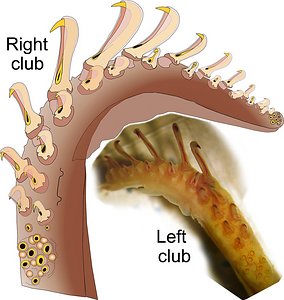
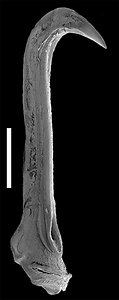
Figure. Tentacle club and hook of W. youngorum, holotype. Left - Oral-dorsal view of the right club. Drawing by R. Young. Photograph of the left club with tip missing. Photograph by R. Young. Right - Scanning electron micrograph of large club hook (hook V5). Photograph from Bolstad, 2010.
- Occipital region
- 3 primary occipital folds; large occipital membrane from fold 3 extends dorsally and curves to join occipital crest without forming a distinct fourth fold. Olfactory organ lies at posterior end of fold no. 2.
- Head
- Beaks: Descriptions can be found here: Lower beak; upper beak.
- The margins of the funnel groove are straight and define a sharply pointed V-shape.
- Beaks: Descriptions can be found here: Lower beak; upper beak.
- Fins
- Oval with large anterior lobes; Fin not drawn-out posteriorly (see title illustration). FL ~30% of ML, FW ~90% of ML. The apical fin-angle is approximately 180°.
- Photophores
- Absent. Note, in the photograph above, that the eye which has popped outside the eyelid, has no photophores on its ventral surface.
- Gladius
- Combined vanes with elongate-rhombic shape; short, blunt rostrum directed perpendicular to tip of gladius.
- Gladius visible in dorsal mid-line except at posterior tip of mantle.
Comments
W. youngorum differs from W. rancureli and W. jeremiahi in their longer, more slender and less recurved club hooks and, possibly their shorter arms. A more detailed description is given in Bolstad, 2010.
Life History
Paralarvae are known as small as 1.9 mm ML. The smallest paralarvae are extremely slender with a mantle width about 25% of the ML. Between this size and about 4-5 mm ML (Fig. A) they are easily recognized by their slender appearance and a distinctive elongate patch of large chromatophores along the dorsal midline. The eyes are dorsoventrally elongate and strongly bulge from the head. Club suckers are in two series, large (about the same size as the arm suckers) and prominent. At roughly 4-5 mm ML (Fig. B) the paralarvae begin a strong morphological change. They start to become relative broad, the eyes become hemispherical and the fins become much more prominent. At 7 mm (Fig. C) the squid is very broad for its length. Chromatophores are small and scattered but larger on the dorsal surfaces than ventral surfaces. On the ventral surface of the head the chromatophores are deep within the tissue and not readily visible in preserved specimens. By 12 mm ML the V-shaped funnel groove and the distinctive rostrum are present and hooks are beginning to form in the medial-ventral series on the club.

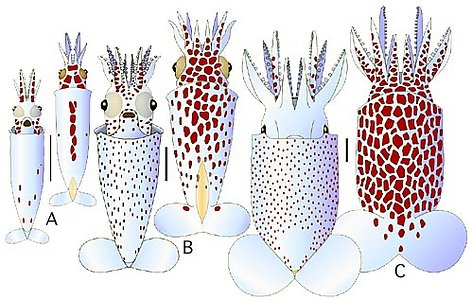
Figure. Ventral and dorsal views of growth stages of paralarvae of Walvisteuthis youngorum., Hawaii. A - Small, slender-stage paralarva, 2.4 mm ML. B - Paralarva in transition between slender and squat-body forms, 4.5 mm ML. C - Squat-stage paralarva, 7.0 mm ML. The scale bar is 1 mm. Drawings by R. Young.


Figure. Walvisteuthis youngorum, dorsal view ??, female, 115 mm ML. Dip-netted floating at the surface. © 2015 Jeff Milisen
Distribution
Geographical distribution. C. youngorum is known only from Hawaiian waters. Judging from its occurrence as paralarvae in plankton samples and as subadults in stomach contents of fishes, especially species of opah, (Lampris spp.) Choy, et al., 2013), it is apparently common in Hawaiian waters in spite of its near absence from the collections of midwater trawls.
Vertical distribution. Since opah near Hawaii spend nearly all of their time in the upper 400m of water (Polovina, et al., 2007), presumably W. youngorum spends at least part of its time there. Indeed if it occupies these depths during the day, it may explain the squid's absence from daytime trawls due to visual avoidance of the nets.
References
Bolstad, K. 2010. Systematics of the Onychoteuthidae Gray, 1847 (Cephalopoda: Oegopsida). Zootaxa 2696: 1–186.
Choy C. A., E. Portner1, M. Iwane and J. Drazen. 2013. Diets of five important predatory mesopelagic fishes of the central North Pacific. Mar Ecol Prog Ser, 492: 169–184.
Polovina, J., D. Hawn and M. Abecassis. 2007. Vertical movement and habitat of opah (Lampris guttatus) in the
central North Pacific recorded with pop-up archival tags. Mar. Biol. DOI 10.1007/s00227-007-0801-2
Title Illustrations

| Scientific Name | Callimachus youngorum |
|---|---|
| Location | Hawaiian waters |
| Specimen Condition | Preserved |
| Sex | Male |
| View | dorsal and ventral |
| Size | 65 mm ML |
| Collection | SBMNH 149643 |
| Type | Holotype |
| Image Use |
 This media file is licensed under the Creative Commons Attribution-NonCommercial License - Version 3.0. This media file is licensed under the Creative Commons Attribution-NonCommercial License - Version 3.0.
|
| Copyright |
©

|
| Scientific Name | Callimachus youngorum |
|---|---|
| Location | Hawaiian waters |
| Identified By | K. Bolstad |
| Sex | Male |
| View | ventral |
| Size | 65 mm ML |
| Image Use |
 This media file is licensed under the Creative Commons Attribution-NonCommercial License - Version 3.0. This media file is licensed under the Creative Commons Attribution-NonCommercial License - Version 3.0.
|
| Copyright |
©

|
About This Page

University of Hawaii, Honolulu, HI, USA
K.S.R. Bolstad

Auckland University of Technology
Page copyright © 2015 and K.S.R. Bolstad
 Page: Tree of Life
Walvisteuthis youngorum .
Authored by
Richard E. Young and K.S.R. Bolstad.
The TEXT of this page is licensed under the
Creative Commons Attribution-NonCommercial License - Version 3.0. Note that images and other media
featured on this page are each governed by their own license, and they may or may not be available
for reuse. Click on an image or a media link to access the media data window, which provides the
relevant licensing information. For the general terms and conditions of ToL material reuse and
redistribution, please see the Tree of Life Copyright
Policies.
Page: Tree of Life
Walvisteuthis youngorum .
Authored by
Richard E. Young and K.S.R. Bolstad.
The TEXT of this page is licensed under the
Creative Commons Attribution-NonCommercial License - Version 3.0. Note that images and other media
featured on this page are each governed by their own license, and they may or may not be available
for reuse. Click on an image or a media link to access the media data window, which provides the
relevant licensing information. For the general terms and conditions of ToL material reuse and
redistribution, please see the Tree of Life Copyright
Policies.
- First online 06 December 2014
- Content changed 11 October 2015
Citing this page:
Young, Richard E. and K.S.R. Bolstad. 2015. Walvisteuthis youngorum . Version 11 October 2015 (under construction). http://tolweb.org/Walvisteuthis_youngorum/145223/2015.10.11 in The Tree of Life Web Project, http://tolweb.org/




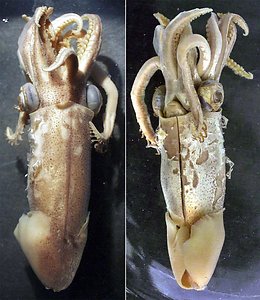
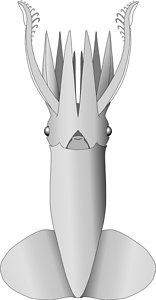
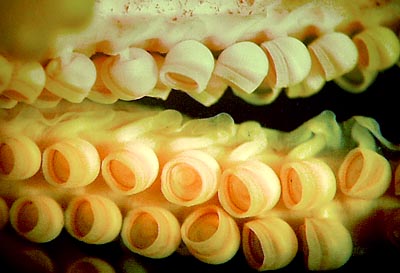
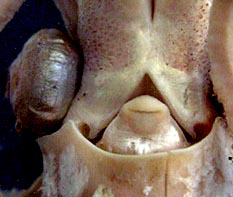
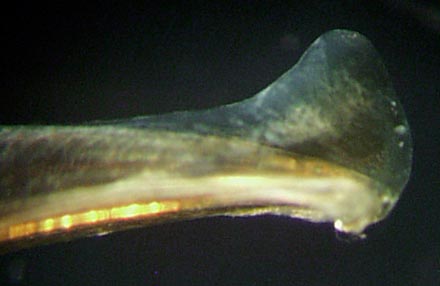




 Go to quick links
Go to quick search
Go to navigation for this section of the ToL site
Go to detailed links for the ToL site
Go to quick links
Go to quick search
Go to navigation for this section of the ToL site
Go to detailed links for the ToL site